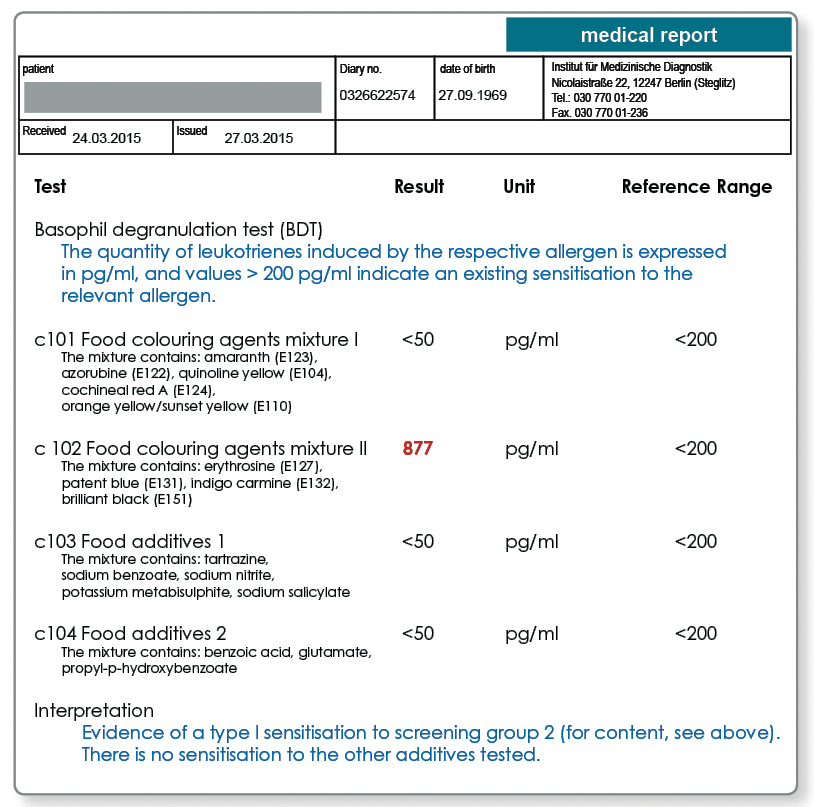Food additive intolerances
Food additives are colouring agents, preservatives, antioxidants, gelling and thickening agents, flavour enhancers, and sweeteners. Where hypersensitivity is individually indicated, some of these E substances or substitutes can trigger pseudoallergic reactions, and even type I (immediate-type) reactions in rare cases. Due to their increasingly widespread use in the food industry and the growing number of approved additives, the frequency of adverse reactions is increasing.
Pathogenesis and symptoms
In 98% of cases, these are pseudoallergic reactions. The clinical picture for this type of intolerance reaction resembles an IgE-mediated allergic immediate-type reaction, but IgE is not involved. Activation of the mast cells does not occur via the IgE binding of an allergen but via direct interactions of the substance with the mast cell activation cascade.
The following clinical symptoms may occur:
- Urticaria (often coupled with Quincke's oedema)
- Rhinitis
- Nasal polyposis
- Obstructions of the airways
- Gastrointestinal symptoms
- Circulatory system reactions
- Migraine
- Eczema
Testing for intolerance of food additives is carried out using the basophil degranulation test (BDT).
As IgE is not the trigger, IgE testing is not involved and nor is the prick test. The basophil degranulation test (BDT) is a modern procedure for detection in vitro. It is also known as the basophil activation test or the CAST test.
In this test, basophil granulocytes from the patient's blood are concentrated and stimulated in the laboratory with the food additives. In the stimulation supernatant, the leukotrienes LTC4, LTD4, and LTE4 are then measured. Increased release in relation to an unstimulated control batch indicates a sensitisation for the patient. According to the current allergological guidelines, the diagnosis must be confirmed by a provocation test.
If there is a suspected intolerance to food additives, we recommend testing with the 18 substances specified below in four group screening tests:
Food colouring agents mixture I
- Amaranth (E123)
- Azorubine (E122)
- Quinoline yellow (E104)
- Cochineal red A (E124)
- Orange yellow (E110)
Food colouring agents mixture II
- Erythrosine (E127)
- Patent blue V (E131)
- Indigo carmine (E132)
- Brilliant black (E151)
Food additives I
- Tartrazine (E102)
- Sodium benzoate (E211)
- Sodium nitrite (E250)
- Sodium salicylate
- Potassium metabisulphite (E224)
Food additives II
- Iron oxide (E172)
- Benzoic acid (210)
- Monosodium glutamate (E621)
- Propyl-p-hydroxybenzoate (E216)
If there is a positive result in the group screening, the substances can be tested individually. However, this requires a new blood sample!
If a particular substance is suspected, individual testing can be carried out first (e.g. glutamate in the case of suspected Chinese food syndrome).
Material
BDT for food additives:
4 ml fresh EDTA blood or heparin blood
The blood must be stored in an unchilled environment and reach the lab within 24 hours. Please use our nationwide courier service.
Literature
- Ballmer-Weber BK et al. Predictive value of the sulfidoleukotriene release assay in oral allergy syndrome to celery, hazelnut, and carrot. J Investig Allergol Clin Immunol. 2008;18:93-99.
- Sabato V et al. Human basophils: a unique biological instrument to detect the allergenicity of food. J Investig Allergol Clin Immunol. 2011;21:179-184.
- de Weck AL et. Al. Cellular allergen stimulation test (CAST) 2003, a review. J Investig Allergol Clin Immunol. 2004;14:253-273.

